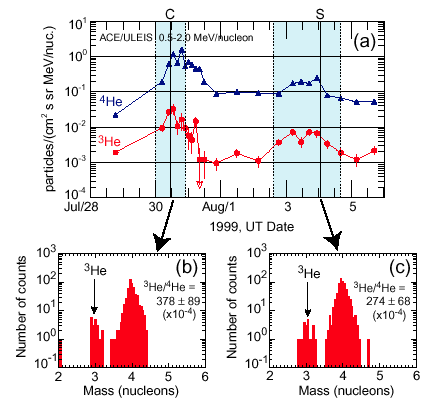
| ACE News Archives | ACE News #44 - April 25, 2000 |
ACE News Archives |

The seed population of ions accelerated at coronal and interplanetary shocks driven by coronal mass ejections (CMEs) is neither well explored nor fully understood. Recently, Mason et al. (1999) have shown that energetic (>0.5 MeV/nucleon) 3He ions from impulsive solar flares can be present in the interplanetary medium at ~1 AU for >50% of the time. They suggested that since the remnant 3He and other material from impulsive flares is more energetic than either the solar wind or the ambient coronal material, it could be re-accelerated efficiently at interplanetary or coronal shocks. To test this hypothesis, we have surveyed the ion composition measurements obtained by the Ultra Low Energy Ion Spectrometer (ULEIS) associated with 33 interplanetary shocks observed at ACE since August 1997. Panel (a) displays the intensity-time profiles of 4He and 3He ions from 1999, July 28 through August 6. A magnetic compression region (marked C) associated with a CME and a fast forward shock (marked S) were observed during this period (C. W. Smith and R. M. Skoug, private communication). The 4He and 3He intensities are clearly enhanced in association with both the compression region and the shock.
Panels (b) and (c) show that the mass histograms for both events (shaded intervals) have clear peaks at M=3 and M=4, corresponding to 3He and 4He, respectively. The 3He/4He ratio for the events is also given. Notice that the ion intensities associated with the compression region are greater than those associated with the shock, which provides evidence that shock acceleration is probably not the only mechanism by which particles can be accelerated in interplanetary space. This survey shows that the 3He/4He ratio for 18 of the 33 shocks was enhanced between factors of 10-100 when compared with the 3He/4He ratio (~4x10-4) measured typically in the solar wind. Note that in both examples shown here the 3He/4He ratio was elevated (relative to solar wind) in the particle fluxes observed prior to the acceleration events. These results generally support the suggestion of Mason et al. that 3He-enhancements at shocks reflect the availability of seed particles that originated previously in impulsive flares.
Contributed by M. I. Desai, G. M. Mason, and J. R. Dwyer, of the University of Maryland, and J. E. Mazur of the Aerospace Corporation.
See The ULEIS Home Page for additional information on ACE/ULEIS.
Last modified 25 April 2000, by
Andrew Davis